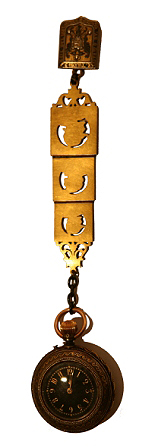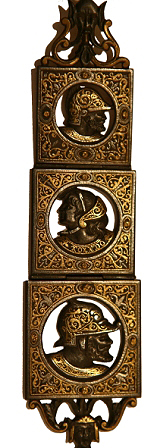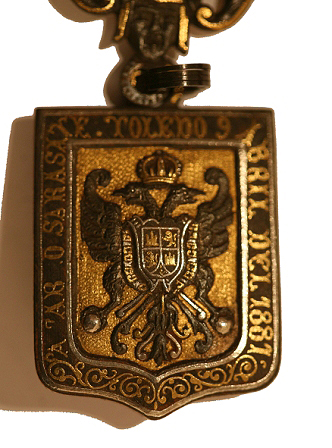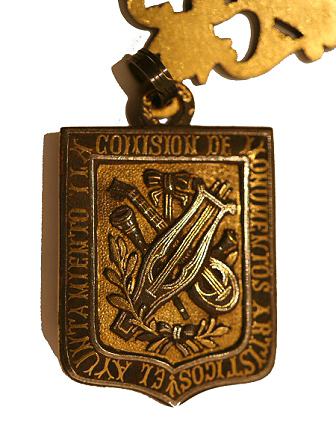The piece of the month of September 2014
POCKET WATCH WITH DAMASCENE WORK
Ignacio Miguéliz Valcarlos
UNED. Pamplona
Pablo Sarasate (1844-1908) is one of the great figures of music not only in Navarre but also in Spain and worldwide. He studied his programs of study in Pamplona, Pontevedra, Madrid and Paris, with scholarships from the Countess widow of Espoz y Mina and Queen Isabella II, among others. In 1857 he obtained the first violin award of the Paris Conservatory, which meant the beginning of a brilliant degree program as a concert performer that led him to play in the best concert halls of Europe and America. Throughout his career he was given gifts by numerous admirers, including not only royalty, such as the Queen of Spain and England or the Empress of Germany, or the aristocracy, such as Princess Metternich, Baron Rothschild or General Schouvaloff, but also by governments from all over the world and anonymous personalities. Many of these gifts were in the form of jewelry, including rings, tie pins, watches, cigarette cases and walking sticks, most of which were bequeathed by the artist, along with other pieces, to the city of Pamplona to be exhibited in the museum that the Pamplona regiment planned to dedicate to his illustrious countryman.
All the jewels given to Pablo Sarasate respond to international models of cultured jewelry and watchmaking, which follow the same patterns and designs, in spite of having been realized in different countries. While the piece studied here, made in damascene work, responds to historicist models and with a technique characteristic of Spain. The clock, which hangs from a chatelaine, is articulated by means of convex lids, with the obverse one showing an equestrian battle scene, framed by a triple border, the outer ones pearled and the inner one with waves. While on the back cover is the circular dial, with Arabic numerals and hour and minute hands, framed by the same borders as on the obverse. The watch has a spring-loaded puller to open the cover and a knob, through which passes a circular ring, and on which is arranged the registration Alvarez. Toledo, topped by a fluted crown. The handle hangs from the chatelaine, formed by three decreasing bodies joined together by chains and masks, and a finishing element in the form of a shield, in which is represented on the obverse the arms of Toledo, bordered by the registration The City Council and the Commission of Artistic Monuments, and on the reverse a still life of musical instruments framed by A Pablo Sarasate. Toledo. April 9, 1881. There follow three square bodies with decoration, only on the obverse, composed of busts of profile of warriors wearing helmets, in Renaissance style, the second of which has at the bottom the word Toledo, inscribed in openwork tondos and surrounded by vegetal elements. As we can see by the inscriptions that it presents, this clock was given to Sarasate by the Commission of Artistic Monuments of Toledo after a benefit concert in favor of the poor of this city, celebrated on April 9, 1881.


Clock given to Pablo Sarasate by the City Council and the Commission of Artistic Monuments of Toledo in 1881.


Clock cover with equestrian battle scene and chatelaine


Top of the chatelaine, with the arms of Toledo and the dedication of the piece.
According to Altadill narrates in Sarasate's biography: Don Pablo was given a magnificent watch whose covers of blued steel, show precious and delicate gold inlays, with the dedication in the obverse and musical attributes in the reverse, artistic and very elegant jewel that the Commission of Historical and Artistic Monuments of the imperial city gave him, for corresponding to this Commission the initiative and managements of that concert. In the accredited factory of arms of Toledo was executed the exquisite work described above.
This piece is a reflection of the importance and boom that the work damascene experienced throughout the second half of the XIX century and beginnings of the XX, with two important centers of production in Spain, Toledo, where this clock was made, and Eibar, workshop of which the Pamplona regiment conserves numerous medals granted by this institution to Pablo Sarasate. In both centers they produced clocks whose covers had a rich damascene decoration, as we can see both from the piece preserved here and from others in private collections. From the same author as this clock, Álvarez, still unidentified, is a cigarette case from the Khalili collection.
bibliography
-ALTADILL, J., Memorias de Sarasate, Pamplona, Imprenta de Aramendía y Onsalo, 1909.
-BRATEAU, P., DAUMAS, M., and ARDIGNAC, R., Dictionnaire des Horlogers Francais, Paris, 1972.
-CHENOUNE, F., A history of men's fashion, Paris, 1993.
-LAVIN, D., The art and tradition of the Zuloaga family. Spanish damascene in the Khalili collection, Bilbao, Bath MidwayPress, 1997.
